What can you tell me about your connection to Amherst College?
I received an honorary degree from Amherst [in 2019]. Amherst is a great college, and it wasn't really necessarily on my radar, although my daughters were getting to that point where they were getting ready for college. That was my first time at Amherst, and I also gave a talk and there was a dinner. And it was all quite wonderful. I remember sitting on the commencement stage, and looking out and seeing the extraordinary audience of young people graduating and being very moved by what I saw. I had just met Biddy, and I was sitting behind her on the podium. I just looked at her and I was admiring her. I got her attention and said, “You know, I'd really like to take your photograph.” And I never do that! I can't believe I was saying that, here on the commencement stage.
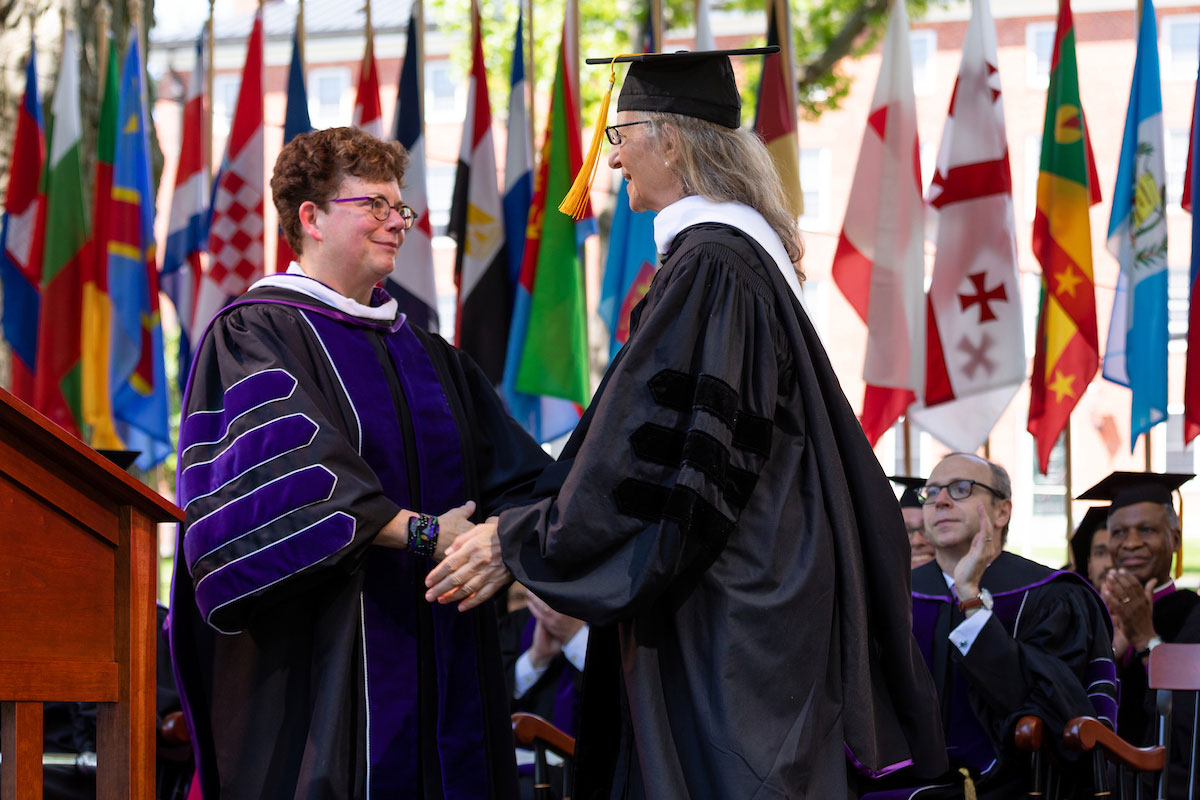
Annie Liebovitz received an honorary degree from Amherst College in 2019.
How did it come about that you took this photo of Martin?
By the time Biddy was actually sitting for the portrait, Sarah [Leibovitz ’24] already had decided to go to Amherst. She’s a geology student here. Then, at the same moment, it seemed like Biddy was going to leave Amherst to go on to her next phase in her life. I thought I’d better get this photograph done before she goes off. So, we started to set up some sittings.
What was your initial thought about the direction the photo might take, and how did that thinking evolve?
I thought I was going to do either a photograph for her to use going forward or, maybe, that she’d want to use it as reference material for the painter who might do the portrait for her. I had no agenda about how I was going to photograph Biddy and was trying to talk her into having her portrait painted. I felt it was important that she stayed within the realm of what we see in this genre. There’s more license, more freedom, in a painting than you might have in a photograph. And then, towards the end of the second sitting, she had talked me into [having the photograph hang in Johnson Chapel]. And I started to sweat through my clothes because I really didn't know quite what [the photo] was going to be. I realized she was expecting something from me. By the way, she couldn't have been more nurturing and kind and sweet. She was sort of letting me find my way.
OK, so when I realized that I was going to be doing this, I came over to Johnson Chapel and I sat here and spent some time in this room really looking at the other presidents and, of course, Rose Olver, who broke the barrier of a woman in the room a decade ago. I just knew that if Biddy is going to be here for all eternity, she’s going to have to stand her ground. And this is going to have to be a very strong portrait. This room inspired me to the direction that I would go in.
I’ve been reading your book, Annie Leibovitz At Work, and in it, you talk about doing your homework before you do a shoot. You gave the example of Carla Bruni, who was the wife of Nicholas Sarkozy, the former president of France. Bruni was also a musician, and you listened to her music to get a sense of her. What was the process of learning who Martin is?
I certainly get the Amherst news, and I was really struck by Biddy coming in on a white horse! That could be interesting. And how she was beloved and admired by students, that she had put her writing aside, and what kind of academic she was. She really has spent these last 11 years running the school. And it couldn't have been a tougher time to be the president of a school. I admired her for how she pulled the school along and took the toll of what it meant to run a college through this really very difficult period. And I thought all the decisions she made were pretty good, all the way along.
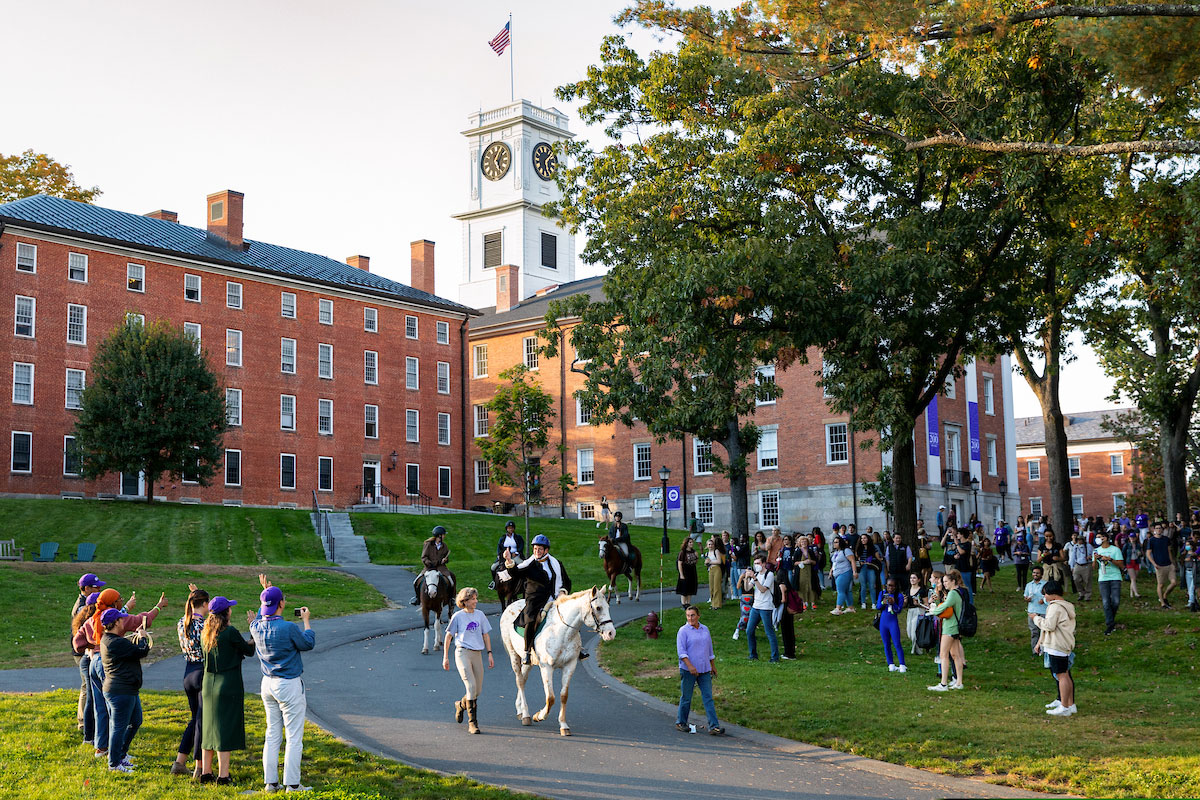
At Amherst College's Bicentennial celebration, Biddy Martin reenacted Zephaniah Swift Moore’s infamous defection from Williams College.
So there was already a built-up understanding of who she was. Then it was really a case of getting to know her, somewhat, by being with her through those two sittings. Then, for how to photograph her, I looked at all the photographs that I could find of Biddy. And you could tell that she wasn't comfortable, necessarily. It wasn't that she wasn't comfortable, but that she really didn't care. It was very like an early Hillary Clinton, who had more important things on her mind than having her photograph taken. It was kind of wonderful.
Let's talk about the painting backdrop. You took a photo of a painting that hangs in Martin’s office, The Oxbow of the Connecticut River. Then you transformed that image, cropping it, re-working the color palette, essentially turning it from a mid-day landscape to a landscape at dusk. How did you hit on the idea of including an actual painting as Martin’s background?
[In our photo sessions], we started in the president's residence, on the back porch and in the gardens. Then we went to Book & Plow, the school farm that Biddy was instrumental in getting going. My daughter happens to be very involved there, and when I would visit Sarah, we would walk up there. It has a great greenhouse. It has great light in it, like a great photography studio. So we set up a portable studio inside the greenhouse, and we worked there.
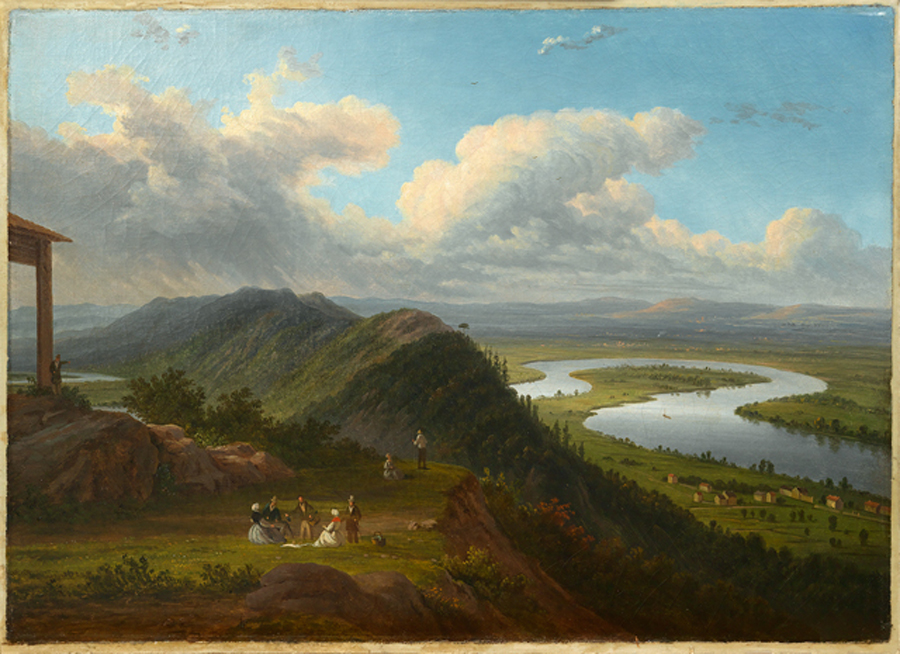
Oxbow of the Connecticut River, oil on canvas based on an engraving by William Henry Bartlett.
It had great views out into the mountains and the hills. I always imagined that there would be a natural background behind Biddy. I didn't want to see her on a gray background. I wanted to, hopefully, find an Amherst background that would suit what we were doing.
During the second session, we went to her office. I didn't want to go to her office. I wasn't sure what we would get from there. But on the wall was a painting after William Henry Bartlett. Bartlett did an engraving of the Oxbow, the view from Mount Holyoke to the Connecticut River. The painting in Biddy's office was based on that engraving but is by an unknown painter. I researched the history on that engraving and the paintings [of the Oxbow].
This all leads into Edward Hitchcock standing on Mount Holyoke and watching floodwaters forming the Oxbow in 1840. It happened over two days. Not only was Hitchcock, who is Amherst's third president, a geologist, but he was also a theologian. At the time, it was kind of extraordinary that he had to grapple with the story of creation and what he observed in front of him—that maybe the Bible's not gospel. It was revelatory at the time. The dinosaur tracks that [he collected] are in the Beneski; he thought they were made by birds, because they didn't believe in extinction at that time. It's all fascinating to me. It's about change. I fell in love with the idea of putting the Oxbow as Biddy's background.
I was looking to see if you’ve ever used paintings as backdrops in your other photographs. There was sort of one with Rob Reiner. Then there’s Steve Martin being painted like—
Franz Kline.
Right. Like a Franz Kline painting. And I know that you were a painting major at San Francisco Artist Institute. Tell me about your connection to painting in your work as a whole and then with the Biddy Martin portrait.
Well, of course, I love painting and all art. I think I'm well-versed in art. I grew up loving art, period. I did try to paint, at the Art Institute, but I wasn't very good at it. I actually loved drawing. And then I discovered photography, and it was so immediate and gratifying, right away.
Biddy’s portrait, this is a hybrid. When Hitchcock was on that mountain in Mount Holyoke, looking at the formation of the Oxbow, it was just a few years before photography was invented. And what Bartlett was doing with his engravings, as he traveled the world, was a form of photography. [Martin’s portrait] is like a kind of collision. Take the Mona Lisa: there's a portrait and then there's a vision behind the person; there's depth. I could take Biddy’s photograph, and also photograph a painting. What I wanted to do with Biddy's portrait is make it quite clear that it's a painting behind her; there are the crackles in the oil paint and everything.
You can do so much with digital photography today. I sort of feel like I'm painting with it. You can move things around, change backgrounds. I have longed for what painters have, which is that license to move things around within a certain set of limitations.
From beginning to end, it was a difficult process: the whole of how to determine what to do, how to do it, what it should look like, how it should be framed, what was the background. It was a total immersion! So, it was so wonderful to come out the other end with something that one likes. It doesn't happen very often for me. I'm always rushing and having to compromise in some way.
And it was powerful to take in where [the portrait] is going to be, what frame it’s in. Look at all the gold frames in this room. Should Biddy have a gold frame? She's not, like, “gold frame,” you know? The gold is there in part of her frame, as a nod to the Amherst room, but it then breaks out into wood.
The whole process was so moving and wonderful for me, every single step of the way. It’s an interpretation of Biddy, an interpretation of Biddy who must be in this room with mostly men presidents. I mean, she's the only woman president and must stand her ground. That was the idea.
I'd like to go a little granular and ask you specifics about the painting. Let’s start with the clouds. I've noticed that you've used clouds in the background, photographically, with people you’ve photographed, like Catherine Deneuve, Barbara Jordan and Queen Elizabeth.
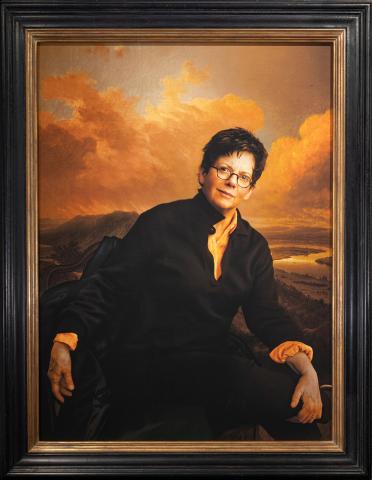
Portrait by Annie Leibovitz; click the photo for a larger version.
I do have a problem. I love clouds, and I love trees. I love nature. I like to shoot outside because I like the natural light. I like mixing the strobe light with the natural light. In fact, it was a very signature look of mine for some time, where it was strobe mixed with ambient light. It was more strobe. As I've gotten older, I’ve found myself subduing the strobe, having it a stop or two below the ambient light.
Today, with the speed of photography, you have 11 stops, a lot of latitude to take something brighter or darker. Really, the work happens now after I take the picture. I sit down in front of that computer—that's the darkroom now.
What can you tell me about Martin’s clothing choice and her facial expression?
In the first session we did a lot in her academic robes, but then she decided she really didn't want to be photographed in the robes. At the very end of the second sitting, Biddy put on that shirt. This orange wouldn't be something I would imagine using. But there was that color aspect to Biddy. She is a lively person, and her look is like, “What are you doing?” That is a great look of hers, because she's thoughtful, inquisitive, curious. I remember Gabi [Strauch, Martin’s wife] and Sue [Englehardt, assistant to the president] saying, “That's her. That's Biddy.”
Why is she leaning in the photo?
I was going in a very formal, traditional route, based on the other Johnson Chapel portraits. And then she sat like that, using her leg as a sort of table. I thought it was a very modern pose.
Did Martin have a particular affinity for the background painting?
It had hung in her office, and she has the ability, like the president of the United States, to pick paintings from the collection. I was very drawn to the history, as it starts to unfold with this particular painting, and what it meant about change. I like that there's a sense of history, that you have the span of painting through to, now, photography. That’s why I like to call this portrait “a construction” rather than a photograph. It shows not only the sense of depth in the photograph but also depth in the sense of life and study and change and nature and climate change.
Were there any paintings here in Johnson Chapel that spoke to you or inspired you? Or did you actually think, I really don't want to emulate what's in here?
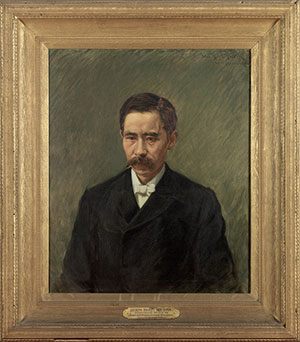
After you took the photo, what was your process like then?
I was living with it in my apartment in New York. I had three or four prints up, and I would wake up in the morning, see it and go ‘No, no, no, no.’ It was like, where would the crop be? How much do you see of the Oxbow? We had the frame made, and I went home and I said, "It's not right. I'm worried about it.” I went back to the woman who built the frame. The final version comprises two or three frames put on top of each other, almost like a box effect to put the photograph in. Everyone was very excited about it.
In your own body of work, where does this fit? Is it a departure? Part of another trend in your work?
I would not do this again. This is for here, unique for Biddy, for Amherst, for this room. I loved working on something like that. That whole part of it interests me a great deal. But it’s a big responsibility. It’s not a magazine or a newspaper or even a book, where you can put it aside. I felt it was so important that this be done right because it's going to be here until the end of time.
Were there any other photographers that influenced your style in this portrait?
I grew up on the shoulders of great, great photographers: Steichen, Avedon, Penn. I wish I could say this came from nowhere, but I am built of a whole world of great classic traditional work. I love what I do, but this is not a whole new thing. I have a great encyclopedia of photography built in me that incorporates everyone, all the great photographers—Paul Outerbridge, Diane Arbus, Helmut Newton, Guy Bourdin—and it's hard to pull out one from the other. Maybe Irving Penn? But I don't think it's an Irving Penn. It's its own thing. If there's any main inspiration or influence, it's this room. That is really where it came from. This room.